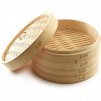Derfor har over 21.000 handlet her
Bamboo steamers and steamers
Bamboo steamer — From China to Denmark
Steaming food is not an unfamiliar method in the kitchen, not even here in Denmark. We most often use an ordinary pot with a little water in the bottom and then a head of broccoli, cauliflower or something similar. When the water comes to a boil it turns to steam, and this steam is trapped by the pot's lid. The result is that the food gets steamed.
It's different, however, in many Asian kitchens, where steamers have been used for the past 5,000 years. The bamboo steamer was invented here during the Han Dynasty, where the bamboo's bark is removed, dipped in water, shaped into a circle, and then finally fastened together with nails. The bottom and top are made from woven strips of bamboo, and making one can take from 15 minutes to several hours, depending on the size.
The bamboo steamer was invented because steaming food could extend its shelf life. That was a useful technique, since back then there were neither refrigerators nor freezers.
Today, steaming food can be advantageous because, for example, no cooking fat is used in the preparation. At the same time, there is minimal cleanup involved, since the bamboo steamer only needs to be wiped with water after use.
Bamboo steamer for everything from vegetables to bread.
A bamboo steamer can be used to steam many different things, and today it is typically used for vegetables, dumplings, or bread. The steamer is especially used for bao, where the buns must be steamed to achieve their distinctive shape and texture. Modern bamboo steamers are built in layers so you can stack the different tiers on top of one another. That way you can easily and efficiently prepare several items at once.
When using a multi-tier steamer, you typically place what needs the most heat on the bottom. This could be fish, meat, or other items that should be fully cooked before eating. On the upper tiers you can place vegetables such as carrots, cabbage, or tofu. However, it's always a good idea to place a layer of parchment paper or cabbage at the base of each tier, including the one where you steam fish, meat, or shellfish. That way you ensure everything is steamed properly and the bamboo steamer is easier to clean afterward.
A bamboo steamer has many advantages.
Are you thinking about getting a bamboo steamer? Then read on — we'll go over a few of the benefits of steaming your food.
-
The lid of a bamboo steamer has small holes that allow condensation to escape. That means your food won't taste strange because of the condensation.
-
Steaming can be used to cook and reheat food. So if you have something in the freezer, a leftover in the fridge, or something similar, it's a good idea to put it in the steamer.
-
You can cook foods with different cooking times at the same time, as long as you place the item that needs the longest cooking time in the bottom basket. It saves both time and energy.
-
A bamboo steamer is lightweight and can easily be stored in a cupboard, on a shelf, or wherever you have room for it.
-
The bamboo steamer can be used for serving, and that's how dumplings are traditionally served in China. So, purely for aesthetic reasons it can be a good buy.
-
While cooking, the bamboo absorbs excess liquid so your vegetables or bread won't get soggy.
-
You can line the bottom of the steamer with paper made especially for that purpose. This protects the bamboo steamer from dirt, and your food won’t pick up the taste of whatever it was used for before.

 EN
EN
 DA
DA
 ZH
ZH















